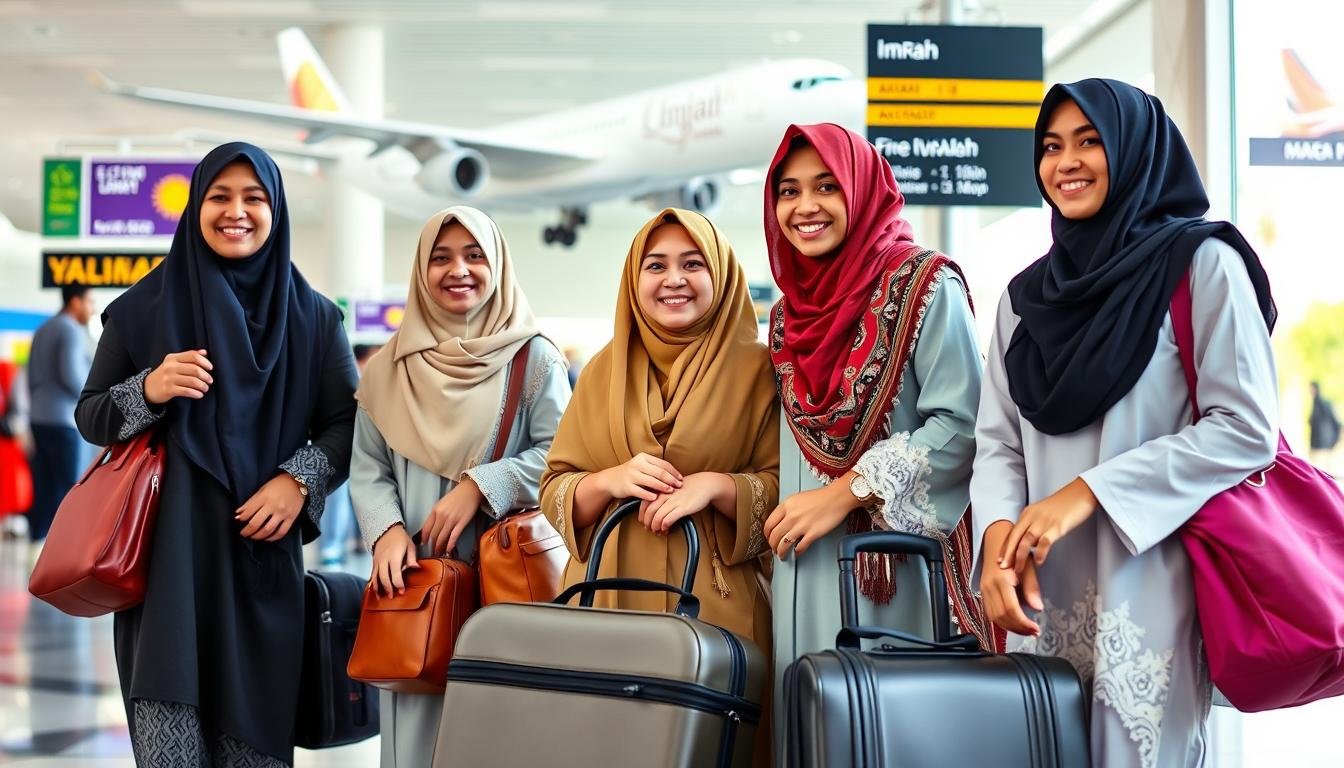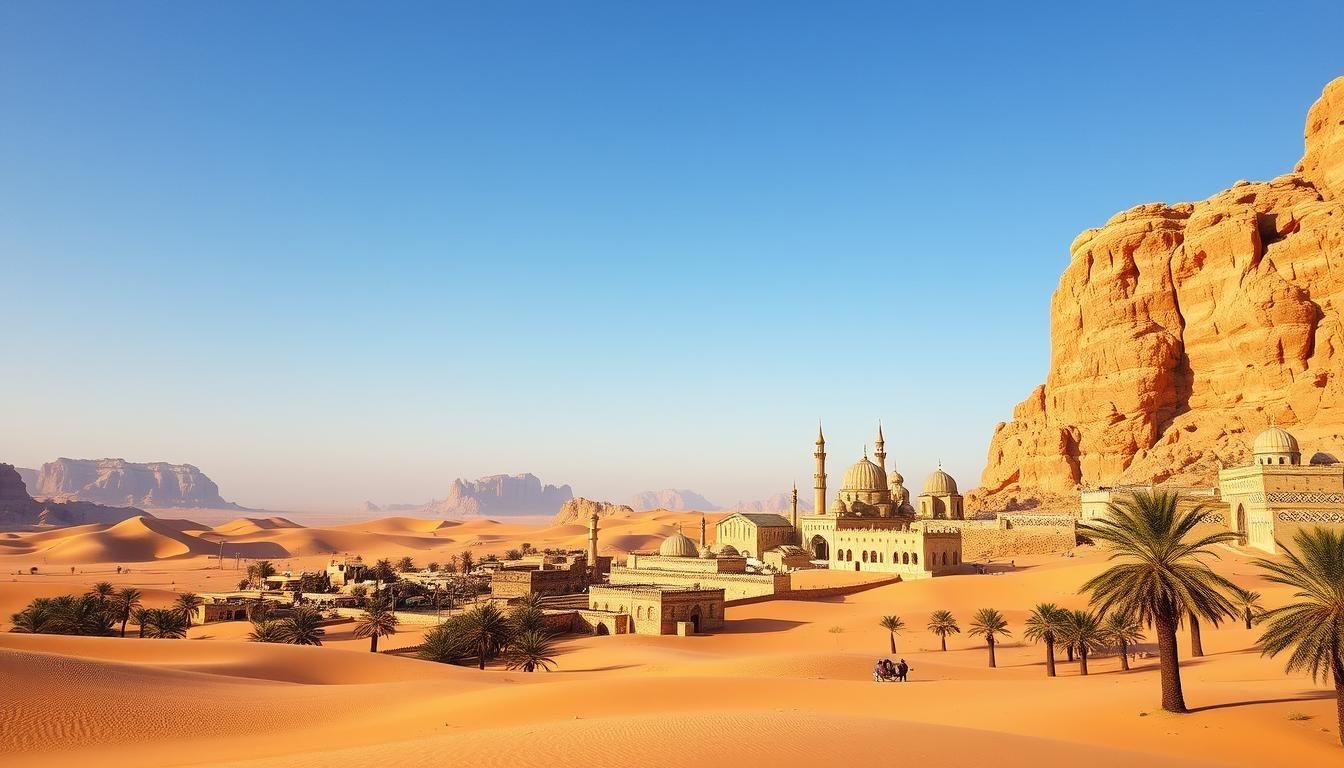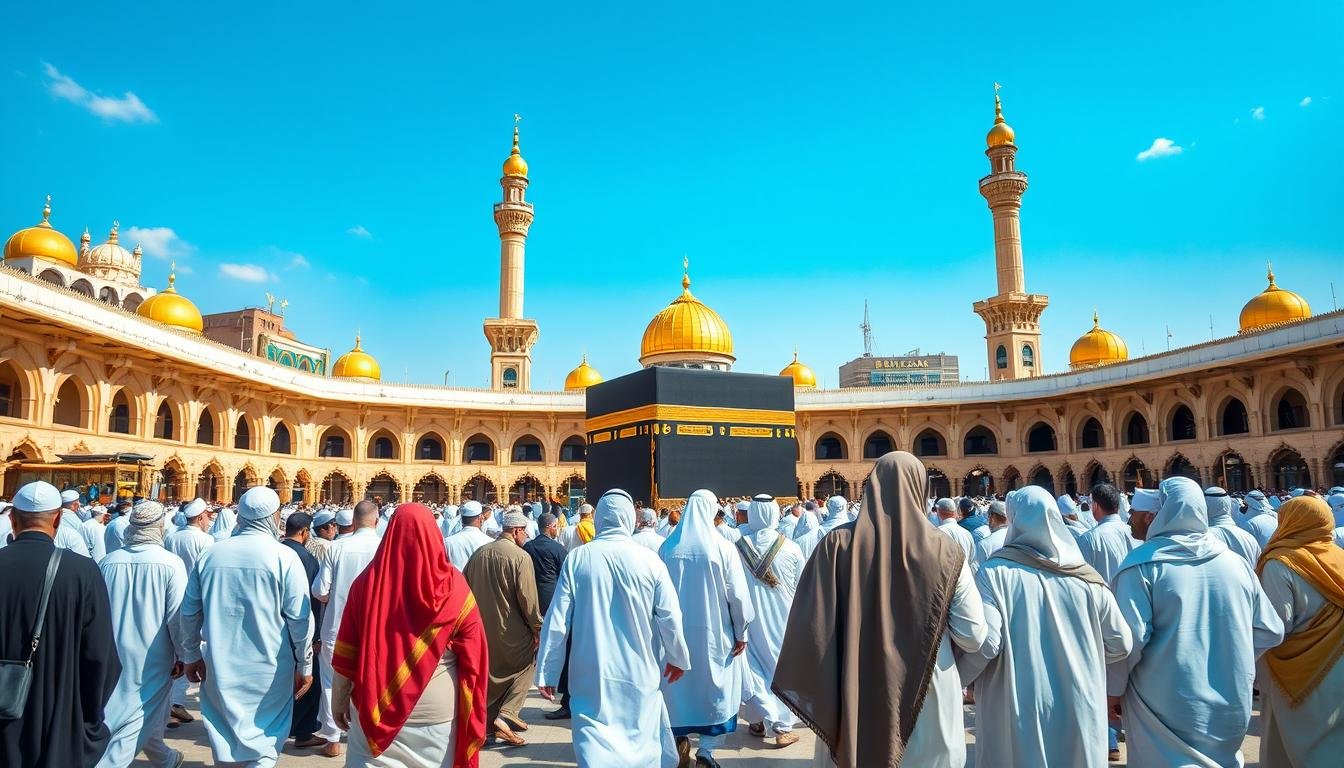I’ve always wanted to visit the holiest sites in Saudi Arabia. These places are key to the Islamic faith. They guide and inspire millions of people around the world.
But what makes these sites so special? Why do they draw pilgrims and curious travelers? Let’s explore the world of Islam’s most revered sanctuaries. We’ll learn about their history, spiritual meaning, and how they shape the Muslim community.
Understanding the Spiritual Significance of Saudi Arabia’s Holy Sites
Saudi Arabia is home to some of the most sacred sites in Islam. These places are key to the Muslim faith and draw millions of pilgrims. Knowing their importance helps us see the deep bond between believers and these sites.
The Role of Sacred Places in Islamic Faith
In Islam, sacred sites are more than just places. They are the heart of the faith, filled with divine presence. Sites like Mecca and Medina and many sacred Islamic monuments are deeply meaningful to Muslims.
Historical Evolution of Islamic Holy Sites
The holy sites in Saudi Arabia have a rich history. They have seen empires rise and fall, and the devotion of countless pilgrims. Their story is one of faith, resilience, and the Muslim community’s spirit.
Religious Significance Through Centuries
The importance of Saudi Arabia’s holy sites has grown over time. They remind Muslims of Islam’s core teachings and inspire a deeper connection with the divine. Sites like the Kaaba in Mecca and the Prophet’s Mosque in Medina can change one’s spiritual journey.
The Sacred City of Mecca: Heart of Islam
Mecca is the holiest site in Islam, deeply meaningful to Muslims everywhere. It’s where the Prophet Muhammad was born and the Kaaba, Islam’s most sacred site, is located. This makes Mecca the heart of the mecca, kaaba, and islamic pilgrimage.
The Kaaba, a cube covered in a black cloth with gold calligraphy, is the center of the Masjid al-Haram mosque. It’s believed to have been built by Abraham and Ishmael. It’s the direction of prayer for Muslims all over the world.
Every year, millions of Muslims go to Mecca for the islamic pilgrimage, the Hajj. They perform sacred rituals and connect with their faith. The Hajj is a key part of Islam, offering a deep spiritual experience.
Mecca also has other important sites like the Zamzam Well and the Mountain of Light. The Zamzam Well is known for its healing powers. The Mountain of Light is where the Prophet Muhammad received his first revelation from God.
Mecca holds a special place in the hearts of Muslims everywhere. It’s the spiritual and physical center of Islam. Its rich history, deep religious meaning, and the devotion of its visitors make it a remarkable place for those seeking a deeper connection with the divine.
A Journey Through Islam’s Holiest Sites in Saudi Arabia
Traveling through Saudi Arabia’s holiest sites is a deep and changing experience. It’s for those who are deeply religious or just want to learn about the culture. This trip will touch your heart and soul deeply.
Planning Your Spiritual Journey
Getting ready for your trip to Saudi Arabia’s sacred places needs careful planning. Knowing the cultural rules and what you need to do will make your visit meaningful. From knowing what to wear to getting the right permits, being well-prepared will help a lot.
Best Times to Visit Holy Sites
When you go can change how you feel at the holy sites. During Ramadan, the sites are filled with a deep spiritual feeling as Muslims from everywhere come together. Or, visiting when it’s not as busy can give you a chance to think and reflect more.
Cultural Etiquette and Requirements
- Dress modestly, covering shoulders and knees.
- Refrain from taking photos or videos inside the holy sites.
- Observe designated prayer areas and times.
- Seek permission before entering any restricted areas.
- Respect the solemnity and reverence of the sacred spaces.
Learning about the cultural rules and needs will help you move through Saudi Arabia’s holy sites with respect and understanding. This will make your spiritual travel journey even more special.
The Grand Mosque and the Holy Kaaba
At the heart of the Islamic faith lies the revered city of Mecca. It is home to the Grand Mosque and the sacred Kaaba. These iconic monuments hold immense spiritual significance for Muslims worldwide.
The Grand Mosque, also known as the Masjid al-Haram, is the largest and most important mosque in the world. It surrounds the Kaaba, a black cube-shaped structure. This structure is considered the most sacred place in Islam.
The Kaaba is believed to have been originally built by the Prophet Abraham and his son Ishmael. It serves as the direction of prayer for Muslims across the globe.
The history of the Grand Mosque and the Kaaba is deeply intertwined with the founding and growth of the Islamic faith. Over the centuries, these structures have undergone numerous renovations and expansions. This reflects the evolving spiritual and cultural significance of Mecca in the Muslim world.
| Feature | Grand Mosque | Kaaba |
|---|---|---|
| Architecture | Expansive, with multiple prayer halls and courtyards | Cube-shaped, covered in a black cloth embroidered with Quranic verses |
| Religious Significance | The most sacred mosque in Islam, the direction of prayer for Muslims worldwide | Considered the most sacred site in Islam, the symbolic center of the Muslim world |
| Historical Importance | Numerous expansions and renovations over the centuries, reflecting the growth of Islam | Believed to have been originally built by the Prophet Abraham and his son Ishmael |
The Grand Mosque and the Kaaba stand as powerful symbols of the Islamic faith. They draw millions of pilgrims to Mecca each year. These sacred Islamic monuments serve as a testament to the enduring spiritual and cultural legacy of Islam.
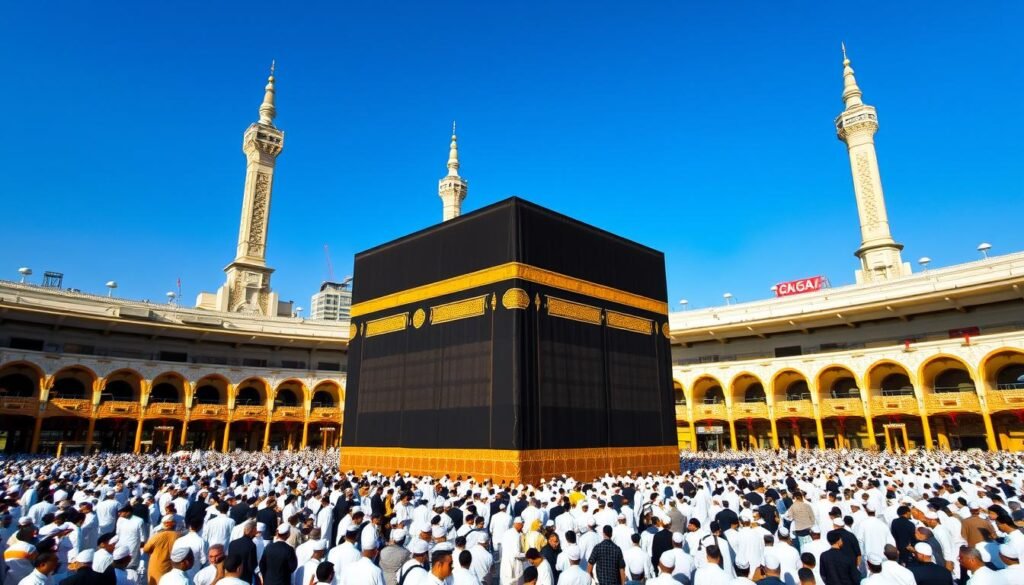
Exploring Medina: The Prophet’s City
Medina is the second-holiest city in Islam, attracting pilgrims from all over. It’s set in Saudi Arabia’s desert, with the Prophet Muhammad’s Mosque at its heart. This mosque is a symbol of the Prophet’s legacy and the Islamic pilgrimage.
The Prophet’s Mosque Architecture
The Prophet Muhammad’s Mosque, or Masjid al-Nabawi, is a stunning sight. It has tall minarets, beautiful domes, and a large courtyard. The mosque combines traditional Islamic styles with modern features, offering a memorable Islamic pilgrimage experience.
Historical Landmarks in Medina
- Masjid al-Qiblatain: This mosque marks the change in prayer direction from Jerusalem to Mecca.
- Jannat al-Baqi: The famous cemetery where many of the Prophet’s family and companions are buried.
- Mount Uhud: The site of a historic battle between early Muslims and their opponents, now a pilgrimage site.
Spiritual Experiences in the City
Visiting Medina and the Prophet Muhammad’s Mosque is a deep spiritual journey. The mosque’s courtyards offer a peaceful atmosphere. Being near the Prophet’s tomb is a unique chance to connect with Islamic faith and history.
Sacred Mountains and Historical Sites
Saudi Arabia is home to more than just the holy cities of Mecca and Medina. It has a wealth of sacred mountains and historical sites that are key to the Islamic faith. These places give us a peek into the country’s rich history and are spiritual havens for travelers and pilgrims.
Mount Arafat, or the “Mount of Mercy,” is a revered peak in Saudi Arabia. It’s where the Prophet Muhammad gave his final sermon. This makes it a key spot for the Hajj pilgrimage. Pilgrims gather here to reflect and seek divine forgiveness and blessings.
Jabal al-Nour, or the “Mountain of Light,” is another sacred site. It houses the Cave of Hira, where the Prophet Muhammad received his first Quranic revelation. This event is a cornerstone in the history of Islamic monuments and the Islamic faith’s beginnings.
| Sacred Site | Significance | Visitor Highlights |
|---|---|---|
| Mount Arafat | Site of the Prophet Muhammad’s final sermon | Pilgrimage during Hajj, spiritual reflection |
| Jabal al-Nour | Location of the Hira Cave, where the first Quranic revelation occurred | Exploring the historic cave, appreciating the site’s spiritual legacy |
| Jabal Uhud | Battlefield where the Battle of Uhud took place, a pivotal moment in Islamic history | Visiting the site of the battle, learning about its historical significance |
Jabal Uhud is another historical site worth visiting. It’s where the Battle of Uhud happened, a crucial event in Islamic history. Visitors can see the battlefield and learn about the struggles and victories that shaped Saudi Arabian culture and its spiritual legacy.
These sacred mountains and historical sites offer a deep and transformative spiritual travel experience. They allow visitors to connect with the traditions and beliefs that have shaped the Islamic faith for centuries.
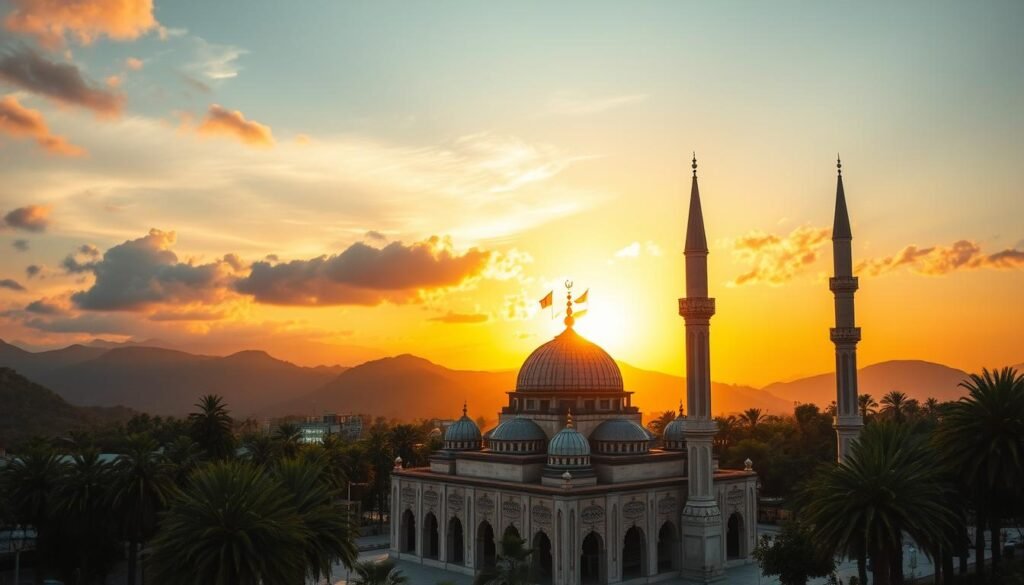
Modern Developments Around Holy Sites
Saudi Arabia’s religious tourism is booming. The kingdom is upgrading the areas around its Islamic holy sites. This effort aims to improve the experience for millions of pilgrims each year.
Infrastructure and Accessibility
The Saudi government has invested a lot in making it easier to get to the holy sites. They’ve built new airports, high-speed rail lines, and advanced roads. These changes help religious tourists from all over reach the heart of Saudi Arabian culture and join in Islamic pilgrimage rituals.
Contemporary Facilities for Pilgrims
Saudi Arabia is also improving the amenities for pilgrims. They’ve built modern accommodations, dining, and healthcare near the holy sites. These updates meet the needs of the growing number of religious tourists visiting the kingdom.
Future Development Plans
Saudi Arabia has big plans for the future. They aim to develop the areas around the sacred sites with urban planning and sustainable design. They also plan to use the latest technology to make the pilgrim experience better. These plans aim to balance preserving the Islamic faith and culture with modern amenities for religious tourists.
Conclusion
Our journey through Islam’s holiest sites in Saudi Arabia has deepened our understanding. We’ve seen the spiritual importance of these places. From Mecca’s vibrant city to Medina’s historic Prophet’s Mosque, we’ve explored Islamic heritage.
Traveling spiritually through these sites has taught us about Islam’s core beliefs. It has also connected us to ancient traditions and rituals. We’ve learned to respect the reverence and devotion of pilgrims.
Reflecting on our experiences, we see these sites as more than just buildings. They represent the heart of Islamic culture and identity. Our journey has inspired us to delve deeper into spiritual travel and religious tourism.
FAQ
What are the most significant holy sites in Saudi Arabia?
The most important holy sites in Saudi Arabia are Mecca and Medina. Mecca is where the Kaaba, the holiest site in Islam, is located. Medina is where the Prophet Muhammad’s mosque and tomb are found.
Why are these sites so important to Muslims?
These sites are very important to Muslims because they are connected to the Prophet Muhammad. Muslims believe going on the Hajj pilgrimage to Mecca and Medina is a duty. It brings them closer to God.
What can visitors expect to see and experience at these holy sites?
In Mecca, visitors can see the Kaaba and perform rituals like circling it. They can also pray at the Masjid al-Haram. In Medina, they can tour the Prophet’s Mosque and see the Prophet Muhammad’s tomb.
Are there any cultural or religious requirements for visiting the holy sites?
Yes, there are specific rules for visiting the holy sites in Saudi Arabia. Non-Muslims can’t enter Mecca and Medina. Visitors must dress modestly and follow certain etiquette rules in these sacred places.
What are the best times of year to visit the holy sites in Saudi Arabia?
The best times to visit are during the Hajj and Umrah seasons. Hajj happens once a year in the 12th month of the Islamic calendar. Umrah can be done any time of the year. These times offer the most spiritual experiences.
Don’t forget to share your experience in the comments and follow us on social media at the bottom of the site.



